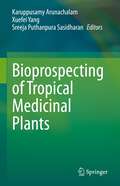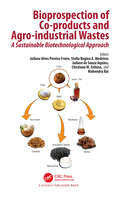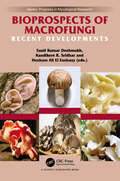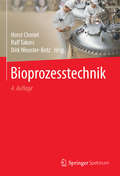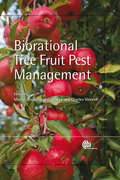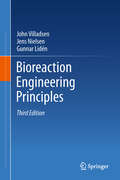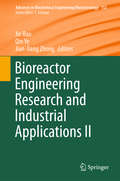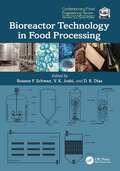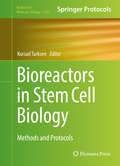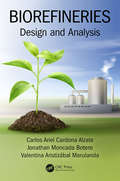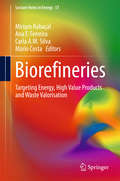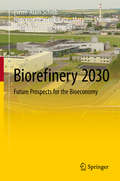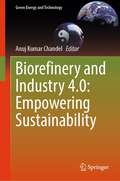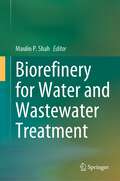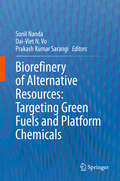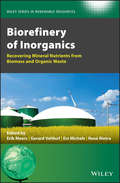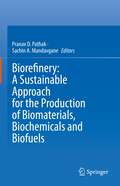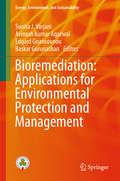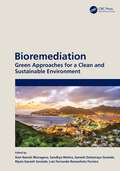- Table View
- List View
Bioprospecting of Tropical Medicinal Plants
by Karuppusamy Arunachalam Xuefei Yang Sreeja Puthanpura SasidharanThis book focuses on natural products, in particular medicinal plants and their derived products, as an indispensable source of bioactive molecules that serve as either drug candidates or lead compounds for drug design and discovery . There are several advantages for plant-derived therapeutics, including wide availability, diverse pharmacological actions, and a generally good profile of safety and tolerability. Over the recent years, there have been numerous reports from clinical studies testifying the efficacy and safety of medicinal plants and phytochemicals in treating human diseases. A plethora of basic studies has also unraveled molecular mechanisms underlying the health benefits of herbal medicines. Nevertheless, issues such as identification of bioactive ingredients, standardization of the products, and drug interactions remain to be systematically documented. Bioprospecting of Tropical Medicinal Plants represents a comprehensive analysis of natural products, mainly medicinal plants and phytochemicals. It includes detailed medicinal properties and pharmacological action from in vitro models to clinical trials. The goal is to present the readers a carefully curated collection of plant-derived natural products and their underlying molecular mechanisms.
Bioprospection of Co-products and Agro-industrial Wastes: A Sustainable Biotechnological Approach
by Joilane Alves Pereira Freire Stella Regina A. Medeiros Jailane de Souza Aquino Chistiane M. Feitosa Mahendra RaiThe proposed book titled as “Bioprospection of Coproducts and Agro-industrial Wastes: A Sustainable Biotechnological Approach”, seeks to offer the importance of the recycling, reuse of food residue, byproducts of fruits and agri-wastes to the academic community and industries. In developing countries facing malnutrition and environmental problems, this book would be very useful. The food waste and the residues resulting from this process are now becoming environmental problems. These mainly include leaves, stems, seeds, bark, and roots that have high nutritional value, many times even greater than the part usually consumed. It is a pressing priority to reuse and recycle the waste which is detrimental to the environment. This book would be an essential reading for students, researchers, and people from the food and pharma industry.
Bioprospects of Macrofungi: Recent Developments (Progress in Mycological Research)
by Sunil Kumar Deshmukh Kandikere R. Sridhar Hesham Ali El EnshasyThe discipline of mycology is a fascinating one. It has a major influence on the nutrition, health and environmental safety of mankind. Cultivation of edible and non-edible mushrooms for nutrition, pharmaceuticals, biopolymers and biocomposites will open up new avenues in research as well as the more profitable utilization of agricultural residues. Cultivation and of domesticated and wild mushrooms poses a challenge to fulfill the needs of human/animal nutrition and utilization of agrowastes tangibly. Cultivation of ectomycorrhizal fungi benefits nutrition as well as plant protection. Macrofungi are the major source of several metabolites of nutritional, health, agricultural and industrial significance (e.g., antioxidants, antimicrobials and pigments). Macrofungal bio composites provide alternatives to the use of animal-derived or plant-derived products (e.g., nanopapers, leather and packaging materials). They serve a dual role in providing nutrition and pharmaceuticals (nutraceuticals) to humans as well as livestock. Macrofungi interact with insects symbiotically (e.g., Termitomyces with termites) and provide delicious nutraceutical product. They also control insects by infecting and producing pharmaceutically and metabolite-rich products (e.g., Cordyceps attacks insects). Macrofungi have a strong potential to control pathogens like nematodes in soil (bioremediation). They are also useful as biofertilizers to meet the needs of plant nutrition. The book outlines current advances in macrofungal technology. It highlights different facets of macrofungal cultivation, bioactive compounds, biocomposites, nutraceuticals, benefits with interaction with insects, application as biofertilizers and ecosystem services like bioremediation.
Bioprozesstechnik
by Dirk Weuster-Botz Ralf Takors Wolfgang Zettlmeier Horst ChmielDieses Werk wurde erstmals 1991 von Horst Chmiel herausgegeben und hat sich inzwischen als Standardwerk sowohl im Studium als auch in der Praxis der Biotechnologie etabliert. Die in weiten Teilen neue 4. Auflage des Lehrbuchs Bioprozesstechnik bietet eine umfassende Einführung zu allen Aspekten der modernen Bioprozesstechnik. Am Anfang stehen Beiträge zur Kinetik von Enzymen und Mikroorganismen, gefolgt von einem Kapitel zu Prozessmodellen. Weitere Beiträge beschäftigen sich mit den Fließeigenschaften von Biosuspensionen und deren Einfluss auf Transportvorgänge. Die Funktionsweise von Bioreaktoren und das Problem der Sterilität sowie die Mess- und Regeltechnik werden ausführlich behandelt. Oftmals entfallen mehr als die Hälfte der Kosten eines Bioprodukts auf die Aufarbeitung, ihr wird deshalb besondere Beachtung geschenkt. Der Beschreibung von ausgewählten Bioprozessen sind drei Kapitel gewidmet, bevor das Buch mit einem Beitrag zu systembiologischen Aspekten der Bioprozesstechnik abgeschlossen wird.
Biorational Tree Fruit Pest Management
by Martin Aluja Tracy C. Leskey Charles VincentFocusing on insect pests of tree fruits and combining behavioral research with crop protection applications, this book emphasizes the importance of environmentally sustainable approaches in an agricultural ecosystem.
Bioreaction Engineering Principles: Second Edition
by Gunnar Lidén Jens Nielsen John VilladsenThe present text is a complete revision of the 2nd edition from 2003 of the book with the same title. In recognition of the fast pace at which biotechnology is moving we have rewritten several chapters to include new scientific progress in the field from 2000 to 2010. More important we have changed the focus of the book to support its use, not only in universities, but also as a guide to design new processes and equipment in the bio-industry. A new chapter has been included on the prospects of the bio-refinery to replace many of the oil- and gas based processes for production of especially bulk chemicals. This chapter also serves to make students in Chemical Engineering and in the Bio-Sciences enthusiastic about the whole research field. As in previous editions we hope that the book can be used as textbook for classes, even at the undergraduate level, where chemical engineering students come to work side by side with students from biochemistry and microbiology. To help the chemical engineering students Chapter 1 includes a brief review of the most important parts of microbial metabolism. In our opinion this review is sufficient to understand microbial physiology at a sufficiently high level to profit from the rest of the book. Likewise the bio-students will not be overwhelmed by mathematics, but since the objective of the book is to teach quantitative process analysis and process design at a hands-on level some mathematics and model analysis is needed. We hope that the about 100 detailed examples and text notes, together with many instructive problems will be sufficient to illustrate how model analysis is used, also in Bio-reaction Engineering.
Bioreactor Engineering Research and Industrial Applications I (Advances in Biochemical Engineering/Biotechnology #152)
by Jian-Jiang Zhong Qin Ye Jie BaoThis book review series presents current trends in modern biotechnology. The aim is to cover all aspects of this interdisciplinary technology where knowledge, methods and expertise are required from chemistry, biochemistry, microbiology, genetics, chemical engineering and computer science. Volumes are organized topically and provide a comprehensive discussion of developments in the respective field over the past 3-5 years. The series also discusses new discoveries and applications. Special volumes are dedicated to selected topics which focus on new biotechnological products and new processes for their synthesis and purification. In general, special volumes are edited by well-known guest editors. The series editor and publisher will however always be pleased to receive suggestions and supplementary information. Manuscripts are accepted in English.
Bioreactor Implementation in the Agro-Food Industries: Technology, Kinetics and Modelization (ISTE Consignment)
by Mohamed GhoulThe use of bioreactors in food ingredient production has expanded rapidly in recent years. These processes create a controlled environment that is tailored to the specific needs of each microorganism, while also minimizing their environmental impact. However, to optimize the implementation of these processes, it is necessary to master a number of scientific concepts relating to material and heat balances, thermodynamics, microbial kinetics, extrapolation and agitation techniques, as well as the techno-economic analysis of processes. This book aims to provide an exhaustive and precise presentation of all of these concepts, making them accessible to students, researchers and professionals alike. Bioreactor Implementation in the Agro-Food Industries is structured in two complementary parts. The first part outlines the essential principles of bioreactor engineering. This knowledge is essential if we are to master the biological and physico-chemical processes that take place in bioreactors. The second part presents practical examples of the use of bioreactors for the production of several ingredients and metabolites of interest.
Bioreactor Technology in Food Processing (Contemporary Food Engineering)
by Rosane F. Schwan V. K. Joshi D. R. DiasBioreactor Technology in Food Processing brings peculiarities, specificities, and updates on bioreactors and bioprocesses related to food and beverage production. The 26 chapters of this book are the result of the participation of more than 70 professionals, including professors, researchers, and experts from the industrial sector from different countries around the world.The chapters cover such topics as history, classification, scale-up, analytical tools, and mathematical and kinetic models for the operation of bioreactors in the food industry. In addition, chapters detail the characteristics of bioreactors for the production of food (bread, cheese, and coffee fermentation) and fermented beverages (beer, wine), distilled beverages, and organic compounds such as enzymes, acids, aromas, and pigments (biocolorants), among others.Key Features: Describes the basic and applied aspects of bioreactor in food processing Gathers information on bioreactors that is scattered in different journals and monographs as reviews and research articles Covers various types of bioreactors including stirred tank, airlift, photo-bioreactor, and disposable bioreactors Gives a broad overview of what exactly is involved in designing a bioreactor and optimizing its performance and finally their applications in the food processing industry The broad interdisciplinary approach of this book will certainly make your reading very interesting, and we hope that it can contribute to knowledge and instigate creative thinking to overcome the challenges that food bioprocessing brings us.
Bioreactors for Microbial Biomass and Energy Conversion (Green Energy And Technology)
by Qiang Liao Jo-Shu Chang Christiane Herrmann Ao XiaThis book discusses recent trends and developments in the microbial conversion process, which serves as an important route for biofuel production, with particular attention to bioreactors. It combines microbial conversion with multiphase flow and mass transfer, providing an alternative perspective for the understanding of microbial biomass and energy production process as well as enhancement strategy. This book is relevant to students and researchers who work in the fields of renewable energy, engineering and biotechnology. Policymakers, economists and industry engineers also benefit from this book, as it can be used as a resource for the implementation of renewable energy technologies.
Bioreactors in Stem Cell Biology: Methods and Protocols (Methods in Molecular Biology #1502)
by Kursad TurksenThis meticulous volume recognizes the need to translate what has been learned primarily in tissue culture dishes to approaches supporting scale-up studies, not only to large quantities of cells but also to heterogeneous cell constructs. Notable advances are being made in these latter approaches, prompting this collection of a variety of representative protocols that facilitate important modifications and novel approaches to bioreactors in stem cell research, contributed by both established and new investigators in this area. Written for the highly successful Methods in Molecular Biology series, chapters include introductions to their respective topics, lists of the necessary materials and reagents, step-by-step, readily reproducible laboratory protocols, and tips on troubleshooting and avoiding known pitfalls. Practical and authoritative, Bioreactors in Stem Cell Biology: Methods and Protocols will serve as an ideal guide for scientists seeking to increase our understanding of stem cells and their potential to repair and regenerate tissues and organs.
Bioreduction of Selenite and Tellurite by Phanerochaete Chrysosporium (IHE Delft PhD Thesis Series)
by Erika Jimena Espinosa-OrtizSelenium (Se) and tellurium (Te) are metalloids of commercial interest due to their physicochemical properties. The water soluble oxyanions of these elements (selenite, selenate, tellurite and tellurate) exhibit high toxicities; hence, their release in the environment is of great concern. This study demonstrates the potential use of fungi as Se- and Te-reducing organisms. The response of Phanerochaete chrysosporium to the presence of selenite and tellurite was evaluated, as well as its potential application in wastewater treatment and production of nanoparticles. Growth stress and morphological changes were induced in P. chrysosoporium when exposed to selenite and tellurite. Synthesis of Se0 and Te0 nanoparticles entrapped in the fungal biomass was observed, as well as the formation of unique Se0-Te0 nanocomposites when the fungus was cultivated concurrently with Se and Te. The response of P. chrysosporium to selenite exposure was investigated in different modes of fungal growth (pellets and biofilm). A bioprocess for selenite removal and Se0 nanoparticles recovery using an up-flow fungal pelleted reactor was developed. 70% selenite removal (10 mg Se L-1 d-1) was achieved under continuous mode. The use of Se0 nanoparticles immobilized in P. chrysosporium pellets as a new sorbent material for the removal of heavy metals from wastewater was demonstrated.
Biorefineries: Design and Analysis
by Carlos Ariel Alzate Jonathan Moncada Botero Valentina Aristizábal MarulandaAimed at presenting a systematic design of biorefineries, the book initiates with an overview about relevance and applications explained through origin of raw materials, transformation routes and products. Then, concepts as hierarchy, sequencing and integration are considered which helps in generating a sustainable and strategic design of biorefineries. Further, framework for biorefineries based on techno-economic, environmental and social aspects is analyzed with examples to show the applications. Finally, some mass, energy and economic indices are considered to assess the biorefinery sustainability and key challenges for future development of biorefineries. Key Features Presents current state-of the-art of the biorefineries design and analyses for in depth understanding of biofuels and biomaterials Explores conceptual design of processes Concepts discussed with strong engineering approach, including design strategies and techno-economic analyses Includes bio-based materials, natural products and food products in the biorefinery concept Presentation of structured method to calculate indices of performance of biorefineries
Biorefineries
by Miriam Rabaçal Ana F. Ferreira Mário Costa Carla A. SilvaThis book addresses the potential of the transformation of biomass into a wide range of marketable products, and examines the biological, biochemical, physical and thermal processing of biomass into products such as fuels, power, heat, feeds, chemicals and materials. Respective chapters explore various topics including biomass characterization, biomass pre-conditioning and sustainability analysis, aspects that are supplemented by a global overview of their implementation in current pilot bio-refineries. Providing a valuable resource to energy engineers, chemical engineers, biotechnologists and economists, this book will also be of great interest to students and policymakers.
Biorefinery 2030: Future Prospects for the Bioeconomy
by Pierre-Alain Schieb Honorine Lescieux-Katir Maryline Thénot Barbara Clément-LarosièreThis book investigates the functioning and ecosystems of biorefineries and assesses the potential of the industrial bioeconomy. The authors present a case study of the biorefinery at Bazancourt Pomacle, near Reims, France, as an outstanding illustration of the creation, work processes, financing, provision of environmental services, competitive benefits and future prospects of a bioeconomy. Analysing the case of Bazancourt Pomacle, the authors show the wide range of products produced by integrated biorefineries such as food, bioenergy, molecules for cosmetics and nutrients for agricultural use. They also analyse Bazancourt Pomacle as an open innovation platform, which encompasses several layers of R&D, including three department chairs from leading engineering and business schools in France. Illustrating a number of global success stories that started in Bazancourt Pomacle, the authors also investigate the provision of pilot- and demonstration plants as inescapable steps in the scaling-up process from the lab to industrial scale. The book provides a systematic overview of the lessons learned, as well as data on an industrial bioeconomy. Investors, decision- makers, public-policy shapers, analysts and scholars will learn about the history, actors, economics, industrial symbiosis, role of cooperatives, R&D and future prospects of a world-class biorefinery and bio-based cluster in Europe.
Biorefinery and Industry 4.0: Empowering Sustainability (Green Energy and Technology)
by Anuj Kumar ChandelThis book provides a comprehensive overview of the latest advances in the production of low carbon chemicals and biofuels from renewable feedstock, including pilot, demo, and commercial-scale technologies. It highlights the role of Industry 4.0 in improving the efficiency and affordability of biorefineries, ultimately leading to the production of bio-based molecules and energy with low carbon and water footprints. Drawing on the expertise of established researchers, academics, and engineers, the book presents a range of informative chapters on the subject. It explores the key elements of Industry 4.0, such as, interconnectivity and smart process automation, and shows how these can be harnessed to revolutionize industrial processes and offer finished products in a cost-effective manner. With its emphasis on sustainability and cutting-edge technology, this book is an essential resource for anyone interested in the future of low carbon chemistry and bioenergy production.
Biorefinery for Water and Wastewater Treatment
by Maulin P. ShahBio-refinery approach of microbial fermentation, production of biogas, bioenergy, enzymes, bioactive molecules, agricultural nutrient and many more, which is presently restricted to specific journals, review articles and research papers in conference proceedings. Hence, my effort is to provide a complete and globally available advance knowledge in wastewater treatment with an aim of recovery of value added products. This will help in designing new approaches of waste water treatment with this value added thoughts. Thus, it will be a boon for a concern broad range of readers and industry professionals to their means of technology development for pollution prevention and economic growth of the country.
Biorefinery of Alternative Resources: Targeting Green Fuels and Platform Chemicals
by Prakash Kumar Sarangi Sonil Nanda Dai-Viet N. VoThis book summarizes recent advances in the processing of waste biomass resources to produce biofuels and biochemicals. Worldwide interest in clean energy sources, environmental protection, and mitigating global warming is rapidly gaining momentum and spurring on the search for alternative energy sources, especially for the transportation and industrial sectors. This book reviews the opportunities presented by low-cost organic waste materials, discussing their suitability for alternative fuel and fine chemical production, physicochemical characterization, conversion technologies, feedstock and fuel chemistry, refining technologies, fuel upgrading, residue management, and the circular economy. In addition, it explores applied aspects of biomass conversion by highlighting several significant thermochemical, hydrothermal and biological technologies. In summary, the book offers comprehensive and representative descriptions of key fuel processing technologies, energy conversion and management, waste valorization, eco-friendly waste remediation, biomass supply chain, lifecycle assessment, techno-economic analysis and the circular bioeconomy.
Biorefinery of Inorganics: Recovering Mineral Nutrients from Biomass and Organic Waste (Wiley Series in Renewable Resource)
by Christian V. StevensProvides complete coverage of the recovery of mineral nutrients from biomass and organic waste This book presents a comprehensive overview of the potential for mineral recovery from wastes, addressing technological issues as well as economic, ecological, and agronomic full-scale field assessments. It serves as a complete reference work for experts in the field and provides teaching material for future experts specializing in environmental technology sectors. Biorefinery of Inorganics: Recovering Mineral Nutrients from Biomass and Organic Waste starts by explaining the concept of using anaerobic digestion as a biorefinery for production of an energy carrier in addition to mineral secondary resources. It then discusses the current state of mineral fertilizer use throughout the world, offering readers a complete look at the resource availability and energy intensity. Technical aspects of mineral recovery organic (waste-)streams is discussed next, followed by an examination of the economics of biobased products and their mineral counterparts. The book also covers the environmental impact assessment of the production and use of bio-based fertilizers; modelling and optimization of nutrient recovery from wastes; and more. Discusses global production and consumption of mineral fertilizers Introduces technologies for the recovery of mineral NPK from organic wastes and residues Covers chemical characterization and speciation of refined secondary resources, and shows readers how to assess biobased mineral resources Discusses applications of recovered minerals in the inorganic chemistry sector Compares the economics of biobased products with current fossil-based counterparts Offers an ecological assessment of introducing biobased products in the current fertilizer industry Edited by leading experts in the field Biorefinery of Inorganics: Recovering Mineral Nutrients from Biomass and Organic Waste is an ideal book for scientists, environmental engineers, and end-users in the agro-industry, the waste industry, water and wastewater treatment, and agriculture. It will also be of great benefit to policy makers and regulators working in these fields.
Biorefinery Production Technologies for Chemicals and Energy
by Arindam Kuila Mainak MukhopadhyayThe world has shifted towards sustainable development for the generation of energy and industrially valuable chemicals. Biorefinery plays an important role in the integration of conversion process with high-end equipment facilities for the generation of energy, fuels and chemicals. The first part of the book presents the fundamentals of the biorefinery concept. The second part describes the biorefinery approach for production of several industrially important chemicals from waste biomass and agro residues. These chemicals include industrially important C4. C5 and C6 chemicals, propylene glycol, glycerol byproducts, dyes and inks etc. Each and every chemical has its own industrial value and the book describes the production processes and strategies at the industrial level. The final part of the book describes the various biorefinery approaches and economic analysis for the different types of biofuel production.
Biorefinery: A Sustainable Approach for the Production of Biomaterials, Biochemicals and Biofuels
by Pranav D. Pathak Sachin A. MandavganeThis book discusses recent trends and concepts in the field of biorefinery. It discusses optimal and economic strategies for converting biomass to value-added products to maximize profits with minimal environmental impact with a sustainability approach. The chapters of the book are focused on the current technologies, techno-economical aspects, life cycle assessment, and case studies. The book is divided into three sections; the first section presents strategies for the production of biofuels like bioethanol, biomethane, biohydrogen, bio-oil, gasification, etc., from the biomass in a sustainable way. The second sections review the extraction of bioactive chemicals, phenolic antioxidants, enzymes, and carboxylic acid from the biomass residue. The last section examines the utilization of biomass for the production of bioactive materials, including biofertilizers, bioadsorbents, activated carbon, nano-materials, and pigments. This book explores the relation between biofuels and the sustainable development goals (SDGs) 7.
Biorefining of Biomass to Biofuels: Opportunities and Perception (Biofuel and Biorefinery Technologies #4)
by Sachin Kumar Rajesh K. SaniThis volume focuses on the prospects of the conversion of biomass into biofuels including ethanol, butanol, biogas, biohydrogen, biodiesel, syn-gas and other useful products. Biomass-derived fuels have gained tremendous attention worldwide. However, due to high raw material and processing costs, biofuels produced from lignocelluloses have been found to be more expensive than conventional fuels. Therefore, a concept of biorefining has been introduced, where more than one product or each and every component of biomass may be derived into useful products in a manner of petroleum refinery.
Bioremediation: Applications For Environmental Protection And Management (Energy, Environment, and Sustainability)
by Avinash Kumar Agarwal Sunita J. Varjani Edgard Gnansounou Baskar GurunathanThis book examines bioremediation technologies as a tool for environmental protection and management. It provides global perspectives on recent advances in the bioremediation of various environmental pollutants. Topics covered include comparative analysis of bio-gas electrification from anaerobic digesters, mathematical modeling in bioremediation, the evaluation of next-generation sequencing technologies for environmental monitoring in wastewater abatement; and the impact of diverse wastewater remediation techniques such as the use of nanofibers, microbes and genetically modified organisms; bioelectrochemical treatment; phytoremediation; and biosorption strategies. The book is targeted at scientists and researchers working in the field of bioremediation.
Bioremediation: Green Approaches for a Clean and Sustainable Environment
by Ram Naresh BharagavaEnvironmental sustainability with rapid industrialization is one of the current major global challenges. Industries are the key drivers of the world economy. But they are also the major polluters of the environment due to the discharge of partially treated/untreated toxic and hazardous wastes containing organic and inorganic pollutants, which cause severe environmental (soil and water) pollution and toxic effects in living beings. So the adequate treatment of industrial wastes to degrade/detoxify pollutants is of the utmost importance for environmental safety and for promoting the sustainable development of our society with low environmental impacts. Bioremediation: Green Approaches for a Clean and Sustainable Environment showcases the latest information on the different bioremediation approaches used for the many types of industrial pollutants and are dedicated to environmental safety. This book provides a detailed knowledge about the natural as well as anthropogenic sources of different types of toxic pollutants, such as toxic metals, dyes, pesticides, petroleum hydrocarbons and plastics; their fate and transport into the environment; their ecotoxicological effects and health hazards; and different approaches used for their bioremediation for the environmental clean-up. Key Features: Covers the different aspects of environmental problems and their remedies with up-to-date developments in the field of bioremediation of industrial/environmental pollutants Serves as an invaluable source of knowledge for a wide range of students, scientists, and researchers in microbiology, biotechnology, environmental sciences with the fundamental and advanced knowledge about the environmental pollution, challenges, and bioremediation of toxic pollutants
Bioremediation: Methods and Protocols (Methods in Molecular Biology #599)
by Stephen P. CummingsSince its first systematic application during the 1970s, bioremediation, or the exploitation of a biological system's degradative potential to combat toxic pollutants such as heavy metals, polyaromatic hydrocarbons (PAH), cyanides, and radioactive material, has proven itself over time, and the many advances in molecular techniques have only amplified its utility. In Bioremediation: Methods and Protocols, experts in the field explore imaginative and ambitious multidisciplinary techniques that will enable more predictable removal of pollutants from a variety of environments. The easy-to-follow volume addresses some of the broader issues such as the effect of the environment in determining the availability and fate of organic and inorganic compounds and how choices around the most appropriate bioremediation process can be arrived at, as well as detailed complementary techniques that support the effective deployment and monitoring of a bioremediation approach. Written in the highly successful Methods in Molecular BiologyTM series format, chapters include introductions to their respective topics, lists of the necessary materials and reagents, step-by-step, readily reproducible protocols, and notes on troubleshooting and avoiding known pitfalls. Authoritative and cutting-edge, Bioremediation: Methods and Protocols offers researchers a series of invaluable techniques certain to enhance their work with environmental contamination.
